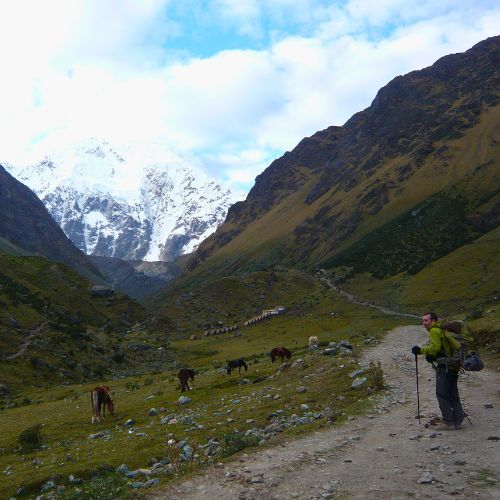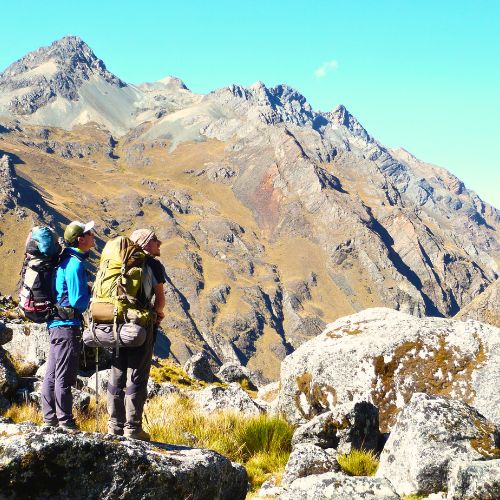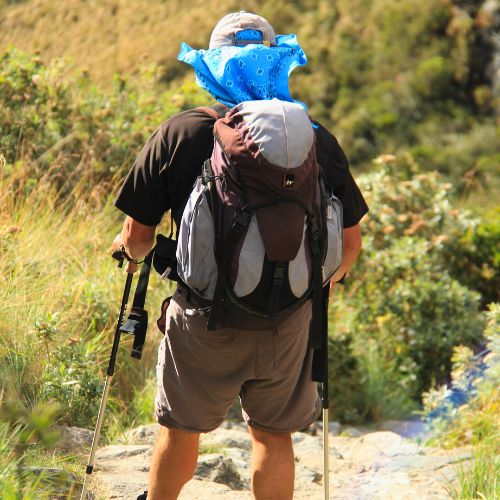The Salkantay Trek is considered a moderate to high difficulty hike. The weather for this route during the rainy season (November to March) is warm and rainy in the lower areas, while in the higher zones, rain and snow may occur. Rainfall is heaviest between January and March. During the dry season (April to October), the weather is drier and colder in the highlands, while the lower areas are warmer and sunnier. Nighttime temperatures in the mountains can be quite cold, so it’s important to bring appropriate clothing for cold weather.
Altitude is one of the main challenges, with the highest point being the Salkantay Pass at 4,630 meters above sea level, which can cause altitude sickness (soroche) in some people. It is recommended to acclimatize for one or two days before starting the hike.
The trek generally lasts between 5 and 7 days, involving long and sometimes difficult walks of more than 6 hours per day. Keep in mind that the trail varies from steep and rocky mountain paths to smoother areas. Some sections can be challenging due to the rough terrain and weather conditions.
Another important aspect to consider is the climate, as the trail crosses cold and snowy areas near Salkantay to warm and humid climates in the lower zones, which can be difficult if you are not prepared. Good physical condition is required for this trek, as the combination of altitude, long walks, and terrain can be demanding for those not accustomed to hiking long distances or in mountainous areas.
Table of Contents
This is the most well-known route, featuring the traditional itinerary of the Salkantay Trek. It is one of the most direct ways to enjoy this trek.
This is a combined option that allows you to enjoy both the Salkantay Trek and part of the Inca Trail.
This is a shorter version of the trek for travelers with limited time who still want to experience the Salkantay Trek.
This is a more relaxed version that allows travelers to enjoy at a slower pace and better acclimatize.
This route skips the high-altitude section for those who prefer a gentler trek.

The weather on the Salkantay Trek varies considerably along the route due to the altitude and diversity of ecosystems it passes through.
Soraypampa (3,800 m): Cold and dry, with temperatures ranging from -5°C to 15°C. Nights are usually very cold, so warm clothing is necessary, as temperatures drop significantly at night.
Salkantay Pass (4,630 m): Extreme cold with a chance of snow or rain, temperatures range from -5°C to 5°C. This is the highest point of the trek, so conditions can be quite harsh. Snowfall is common, especially during the colder months (June to September). The wind can be strong, so it is essential to be well-prepared with waterproof and warm clothing.
Chaullay (2,900 m): Warm and humid with temperatures between 10°C to 20°C. At this stage, the trek descends from the high mountains into the jungle, making the weather much warmer. The climate becomes more tropical, with higher humidity and the chance of rain. This climate shift is noticeable as the altitude drops.
La Playa (2,000 m): Warm and tropical with temperatures ranging from 15°C to 25°C, becoming hotter during the day. The weather is hot with dense vegetation, and it is likely to rain, especially during the rainy season (November to March). Rainfall is intense but brief, common in lower areas.
Aguas Calientes (2,000 m): Warm and humid with temperatures between 15°C to 25°C. Aguas Calientes has a more tropical climate, with a warm and humid environment due to its proximity to the jungle. Rain is common, especially from December to March.

The Salkantay Trek is a challenging hike that passes through a variety of landscapes, from high mountains to tropical jungle, so it is essential to bring the right gear to handle the diverse weather conditions. Here is a list of the essentials you should bring:
Waterproof and windproof clothing as the weather can be unpredictable, so waterproof gear is essential, especially to protect yourself during the rainy season. Likewise, bring warm clothing for the high-altitude areas where temperatures can drop significantly at night, and try to bring comfortable and flexible clothes.
Hat and gloves as in the highest areas (like Salkantay Pass), temperatures can be cold, so these accessories will be useful. A sun hat is also necessary, especially in the lower zones. Trekking shoes must be very comfortable, sturdy, and suitable for uneven terrain. Make sure they are well broken in before starting the trek.
For travel equipment and accessories, it is recommended to bring a lightweight, comfortable backpack where you can carry your belongings. Make sure it has space for water, food, extra clothing, and camping gear. Trekking poles are also recommended to provide stability on steep terrain. Likewise, it is recommended to carry plastic or waterproof bags to keep your belongings dry in case of rain.
Another important recommendation is to use a headlamp for walks that take place at dawn or dusk, but be sure to bring extra batteries.
Sunscreen and lip balm are important to protect against sun exposure, which can be strong in the mountains. Always bring water bottles or hydration systems because the trek is long and it’s best to stay hydrated. Don't forget to include your passport and necessary documents among your personal belongings. If you're a photography lover, be sure to have your camera or phone fully charged. You can also include a small first aid kit with bandages, disinfectant, painkillers, personal medication (like for altitude sickness), and a thermometer. It’s also important to bring insect repellent: In the lower zones, such as the jungle, mosquitoes can be a nuisance.

The Salkantay Trek is a unique experience that offers a combination of adventure, culture, and nature. With proper preparation, it will be one of the most memorable experiences of your life.
It is recommended to arrive in Cusco at least 2 days before starting the trek to adapt to the altitude and avoid altitude sickness. Keep in mind that it’s best to book in advance, especially if you plan to visit Huayna Picchu or Machu Picchu. If you experience symptoms of altitude sickness during your journey, inform your guide immediately.
